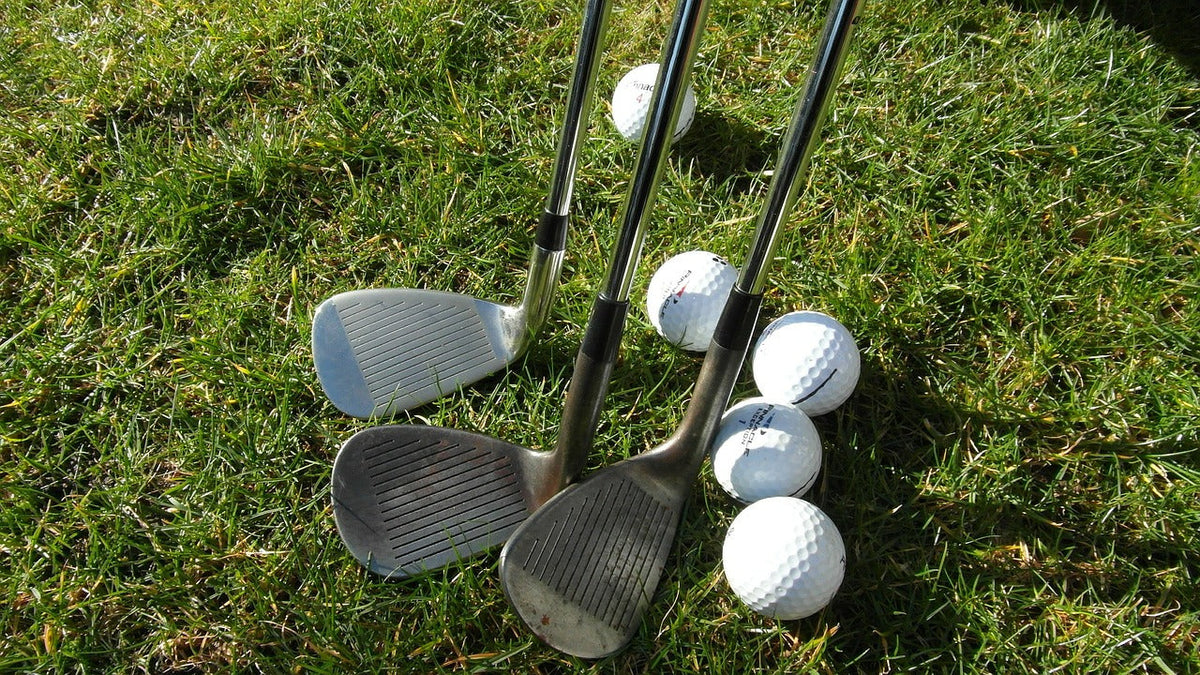

You'll find that approach wedges and gap wedges are actually the same club with different names - manufacturers just use varying terminology. These versatile clubs typically have loft angles between 48-52 degrees and are designed to fill the distance gap between your pitching and sand wedges, helping you nail those tricky 90-110 yard shots. While they're perfect for high-loft pitches and bump-and-run shots, understanding their slight performance distinctions will sharpen your short game considerably.
Table of Contents
Key Features
Approach wedge and gap wedge are the same club type, with manufacturers using different names for marketing purposes.
Both wedges typically have loft angles between 48-52 degrees and work best for shots between 90-110 yards.
These wedges bridge the distance gap between pitching and sand wedges, featuring moderate bounce angles of 8-12 degrees.
The clubs are designed with compact clubheads and minimal offset, prioritizing shot workability over forgiveness.
Proper selection depends on matching with existing iron sets, though specialty options offer varied shot-making capabilities.
Understanding the Terminology: Same Club, Different Names
Confusion often swirls around the golf world regarding wedge terminology, particularly with gap and approach wedges. You'll hear these terms used interchangeably on the course, and there's a good reason for that - they're actually the same club!
When you're shopping for wedges, you'll notice that different manufacturers have their own preferences for naming this versatile club. Some brands stick with "gap wedge," while others opt for "approach wedge," but don't let this marketing twist fool you. Both terms refer to the same piece of equipment that's designed to bridge the distance gap between your pitching wedge and sand wedge. These clubs typically feature a 48-52 degree loft for optimal performance. You can expect this club to help you master shots between 90 and 100 yards with excellent control. Whether you're picking up a gap or approach wedge, you're getting a club that'll help you nail those tricky mid-range shots.
Loft Angles and Distance Coverage

In regard to understanding loft angles and distance coverage, you'll find that gap and approach wedges typically range from 48 to 52 degrees of loft, positioning them perfectly between your pitching wedge and sand wedge. You'll generally use these clubs for shots between 90-110 yards from the green, though your actual distance will depend on your swing speed. For optimal functionality on digital golf training platforms, JavaScript must be enabled to access interactive swing analysis tools. When making your club selection, remember that gap wedges were specifically designed to bridge the distance gap between pitching and sand wedges. For maximum performance, you'll want to maintain consistent 4-6 degree gaps between your wedges. If your pitching wedge is 46 degrees, for example, your gap wedge should be around 50 degrees. This spacing helps prevent those awkward in-between distances that can wreck your score. Both clubs offer excellent control and spin, making them essential for those tricky approach shots where precision matters most.
Design Features and Construction
With regard to gap and approach wedge design, you'll notice several key differences from your other clubs. These wedges feature moderate bounce angles between 8-12 degrees, which helps you glide through different lies while maintaining precision. You'll find they're slightly heavier than your pitching wedge, giving you better control on those tricky partial shots. Most gap and approach wedges have 48 to 54 degrees of loft for optimal trajectory control. Manufacturers often refer to these clubs as A wedges, reflecting their specialized approach shot capabilities. The clubhead typically sports a compact profile with minimal offset and a narrow-to-medium sole width. Unlike your game-improvement clubs, these wedges don't focus on forgiveness features like perimeter weighting. Instead, they're built for workability and clean turf interaction. You'll also find they're usually manufactured to match your iron set's finish and construction method, most commonly with a chrome or satin coating.
Shot Types and Playing Situations
When selecting between a gap wedge and approach wedge, you'll need to evaluate the specific shot types each club excels at handling. Your approach wedge works best for shots between 90-110 yards, providing moderate spin and controlled path that's perfect for firm greens and tight lies. If you're facing longer full swings from the fairway, it's your go-to club. Both clubs are actually the same wedge type, serving identical purposes with loft degrees between 50-54. Having 4-6 degrees of separation between your wedges ensures consistent distance coverage.
Your gap wedge shines in the 80-100 yard range with higher path and more spin, making it ideal for softer greens and precision shots. You'll want to reach for it when you need those high-loft pitches over obstacles or when you're dealing with thick rough. For bump-and-run shots near the fringe, stick with your approach wedge, but trust your gap wedge for those delicate shots requiring quick stops.
Choosing Between Set Matches and Specialty Options
Making the choice between set-matched and specialty wedges doesn't have to be complicated, though you'll need to weigh several key factors. Your skill level, course conditions, and playing style will guide your decision between consistency and versatility. Modern iron sets often include approach wedges to accommodate the stronger lofts in today's clubs.
Set-matched wedges offer seamless shifts from your irons, with similar shaft flex and weighting that'll help maintain your tempo
Specialty wedges give you more shot-making options through varied bounces and grinds, perfect for creative short-game play
Your budget matters too - while set wedges come included, specialty options run $100-200 each
If you're just starting out, stick with your iron set's wedges for simplicity. As your skills improve, you might want to delve into a mixed setup, keeping your gap wedge matched but adding specialty sand and lob wedges for greenside control.
Historical Development and Modern Trends

The fascinating expedition of golf wedges traces back to the early 20th century, well before you'd find today's specialized options in golf bags. Gene Sarazen's groundbreaking flange design in the 1930s sparked a transformation that's still shaping your short game today.
You'll notice how golf manufacturers started de-lofting iron sets in the 1980s to help you hit longer distances, but this created an unexpected challenge - a distance gap between your pitching and sand wedges. That's when gap wedges entered the scene in the early '90s, typically offering 50-52° of loft to fill this void. The modern pitching wedge has evolved so much that it now has 46 degrees of loft, similar to what a 9-iron had in the 1980s. Now, you've got a full range of wedge options, from approach to lob wedges, with state-of-the-art materials and customizable features to match your playing style.
Performance Impact on Your Golf Game
As you consider upgrading your wedge collection, understanding the performance impact of gap wedges can dramatically improve your scoring potential. You'll notice immediate benefits in your short game, particularly when you're faced with those tricky shots between 80 and 110 yards.
Better yardage control means you won't have to stretch your pitching wedge or choke down on your sand wedge
Increased versatility lets you handle both full shots and delicate chips around the green
More confidence in your club selection takes the guesswork out of those awkward distances
Whether you're working on bump-and-run shots or need precise distance control, a gap wedge will become your go-to club. You'll find yourself making smarter shot selections and shaving strokes off your score, especially when you're in that vital scoring zone.
Frequently Asked Questions
Can I Use Approach/Gap Wedges Effectively From Tight Lies or Hardpan?
You'll find gap and approach wedges work well from tight lies, thanks to their balanced bounce and precise design that helps slide under the ball cleanly. However, they're trickier on hardpan surfaces, where you'll need to adjust your technique with a lighter touch. For hardpan shots, you might want to contemplate a sand wedge instead, as its higher bounce offers better performance.
How Often Should I Replace My Approach/Gap Wedge to Maintain Optimal Performance?
Did you know that 75% of amateur golfers keep their wedges too long? You'll want to replace your approach or gap wedge every 75-125 rounds, depending on how often you play and practice. If you're playing twice a week, that's roughly every 12-18 months. Watch for signs like reduced spin, visible groove wear, or decreased control around the greens - these are clear indicators it's time for a new wedge.
Are Approach/Gap Wedges Legal for Tournament Play Across All Skill Levels?
Yes, your approach/gap wedges are legal for tournament play at all skill levels, as long as they conform to USGA standards. You'll need to verify your wedges meet current groove regulations and appear on the USGA's conforming list. While local casual tournaments might be lenient, it's best to play USGA-compliant clubs since they're required for handicap posting and sanctioned events. Remember, pre-2010 wedges may no longer be tournament legal.
Should Beginners Invest in Both Approach and Gap Wedges Initially?
As a beginner, you don't need to invest in both wedges initially. You'll do just fine with one versatile wedge while you're learning the game. It's better to focus your budget and practice time on perfecting a single wedge's techniques before expanding your collection. Once you've developed consistent swing mechanics and understand your distance control, you can consider adding another wedge to your bag.
Do Weather Conditions Affect Which Type of Wedge Performs Better?
Did you know that spin rates can drop by up to 20% in wet conditions? That's why weather plays a huge role in your wedge selection. You'll find approach wedges excel in wet, thick grass thanks to their higher bounce, while gap wedges shine in dry, firm conditions. When it's raining, you'll want your approach wedge's extra forgiveness, but on those sunny days with hardpacked turf, your gap wedge will give you better control and spin.
Conclusion
You'll find that mastering both approach and gap wedges can dramatically improve your short game, with studies showing that 60-80 yards is where most amateurs lose the most strokes. Whether you choose one or both for your bag, remember they're essential tools for different situations. By understanding their unique characteristics and practicing with purpose, you'll gain more control and confidence in those critical scoring opportunities.





